2011

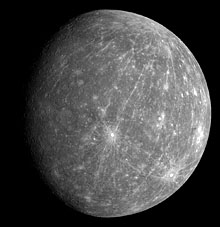
NASA Public Domain Image
March 18, 2011
First Spacecraft to Orbit Mercury
NASA's MESSENGER probe becomes the first man made craft to orbit the closest planet to the Sun. The MErcury Surface, Space ENvironment, GEochemistry and Ranging (MESSENGER) spacecraft begins its mission to map and photograph the planet's surface in high resolution. It will also study Mercury's thin atmosphere and search for signs of water that could lie frozen beneath the surface in areas protected from the Sun.

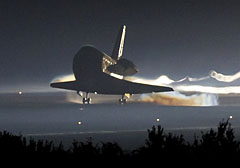
NASA Public Domain Image
July 8, 2011
Final Flight of the Space Shuttle Program
The space shuttle Atlantis becomes the last American space shuttle to be launched into space. Mission STS-135 and its 4-member crew bring much-needed supplies and equipment to the International Space Station (ISS). This is the 135th flight of the space shuttle and the 33rd flight for Atlantis. On July 21, at 5:57 AM eastern daylight time, Atlantis lands at the Kennedy Space Center in Florida for the last time and officially ends the 30-year space shuttle program. Atlantis will be cleaned up and placed on display at the Kennedy Space center starting in 2013. NASA will now look to private companies to provide transportation to low Earth orbit for the ISS and future projects.

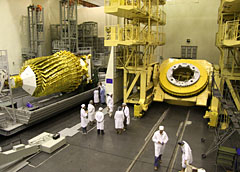
RIA Novosti archive, image #930415 /
Oleg Urusov / CC-BY-SA 3.0
July 18, 2011
Largest Space Telescope Launched
Russia launches the Spektr-R which becomes largest space telescope to be placed into orbit. Spektr-R is a radio telescope designed to study astronomical objects with an angular resolution up to a few millionths of an arcsecond. The telescope is intended for radio-astrophysical observations of extragalactic objects with ultra-high resolution. At launch, the giant telescope weighed 11,000 pounds (5,000 kilograms).

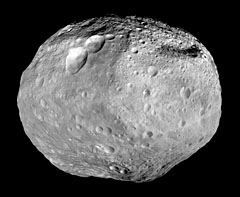
NASA Public Domain Image
July 16, 2011
First Spacecraft to Orbit an Asteroid
NASA's Dawn spacecraft becomes the first man made craft to orbit an asteroid. Launched in 2007, Dawn enters orbit around the asteroid Vesta on July 16, 2011. Vesta is one of the largest asteroids in the Solar System with a diameter of 300 miles (530 kilometers). It is roughly the size of the state of Arizona and is located in the main asteroid belt between Mars and Jupiter. Dawn will remain in orbit around Vesta for about a year, studying and photographing its rocky surface. Dawn will then continue on to study another asteroid called Ceres.
2012

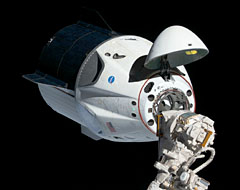
Wikipedia Public Domain Image
May 22, 2012
First ISS Commercial Supply Mission
SpaceX, a commercial space company, launched its Dragon C2+ mission to resupply the International Space Station (ISS). The capsule was launched aboard a SpaceX Falcon 9 rocket. The capsule was captured using the space station's robotic arm and was docked successfully. It remained docked for nearly six days while astronauts unloaded cargo for the space station and loaded Earthbound cargo onto the capsule. The capsule successfully returned to Earth, marking an important milestone for the commercial space program.

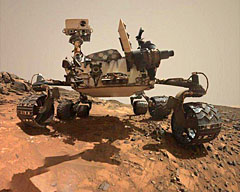
NASA Public Domain Image
August 6, 2012
Curiosity Rover Lands on Mars
NASA's Curiosity rover successfully lands on Mars. It is the largest and most advanced rover ever to land on the red planet. Curiosity's mission is to investigate the climate and geology of Mars and to search the planet for signs of life. As large as a car, it carries an array of advanced new instruments and experiments. The rover will also examine sites on the planet and evaluate them for possible future human missions.

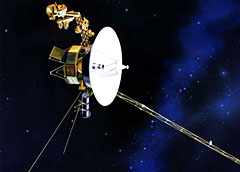
NASA Public Domain Image
August 25, 2012
First Man-made Spacecraft in Interstellar Space
NASA's Voyager 1 probe becomes the first man-made spacecraft to cross into interstellar space. Data received from the probe indicate that it has passed a barrier known as the heliosphere, which marks the extreme outer edge of the Sun's influence. Originally launched in 1977 to study the Solar System, Voyager 1 is now drifting in the space between the stars and is headed for parts unknown.

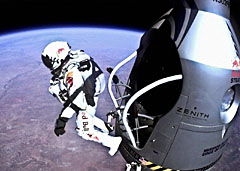
Image © Red Bull
October 14, 2012
First Skydive Jump to Break the Sound Barrier
Australian skydiver Felix Baumgartner becomes the first human being to break the sound barrier without a jet or spacecraft as he jumps from the edge of space. A capsule attached to a helium balloon takes him 24 miles up and he sets a new record, breaking the previous record for highest jump set by Joe Kittinger at 19.5 miles (31.4 kilometers) in 1960. During his descent, he reaches a top speed of 833 mph (1,340 kph).
2014

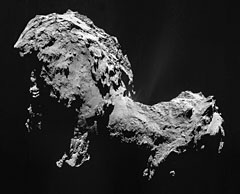
ESA/Rosetta/NAVCAM / CC BY-SA 3.0-IGO
August 6, 2014
First Spacecraft to Orbit a Comet
The European Space Agency's Rosetta space probe becomes the first spacecraft to enter orbit around a comet. After a 10-year, 4 billion-mile journey, Rosetta enters orbit around comet 67P/Churyumov-Gerasimenko. The spacecraft sends back amazing high-resolution images of the comet's surface showing steep 490-foot (150-meter) cliffs and boulders the size of houses. Rosetta will follow the comet as it approaches the Sun and will provide the first close-up images of as it heats heats up and changes to form the classic coma and tail.

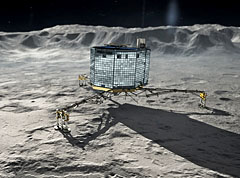
DLR, CC-BY 3.0 / CC BY 3.0 DE
November 12, 2014
First Spacecraft to Land on a Comet
The European Space Agency's Philae lander becomes the first spacecraft to make a soft landing on a comet. Philae is released from the Rosetta space probe and makes a perilous seven hour descent to the surface of comet 67P/Churyumov-Gerasimenko. Harpoons designed to attach the lander to the comet fail to operate, and Philae bounces twice before finally coming to rest on the comet's surface. The spacecraft sends back valuable information about the composition of the comet.
2015

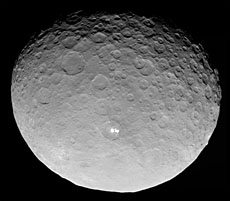
NASA Public Domain Image
March 6, 2015
First Spacecraft to Orbit a Dwarf Planet
NASA's Dawn spacecraft enters orbit around dwarf planet Ceres. Ceres is the largest object in the asteroid belt located between Mars and Jupiter. At 590 miles (950 kilometers) in diameter, it contains 25% of the entire mass of the asteroid belt. Ceres is the only object in the asteroid belt massive enough to have a round shape due to gravity. This classifies it as a dwarf planet instead of an asteroid. Dawn will spend the next year in orbit around Ceres studying its composition and features.

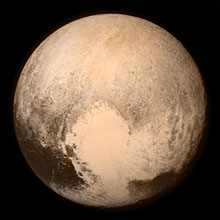
NASA Public Domain Image
July 14, 2015
First Spacecraft to Reach Pluto
NASA's New Horizons spacecraft arrives at Pluto after a journey of more than 9 years and 4.6 billion miles. As the spacecraft makes its closest approach, it passes only 7,750 miles (12,472 km) from the surface of the dwarf planet and captures amazing high-resolution images of Pluto and its largest moon Charon. New data shows that Pluto is about 50 miles (80 km) larger than previously thought and that it has a nitrogen atmosphere extending tens of thousands of miles out into space.

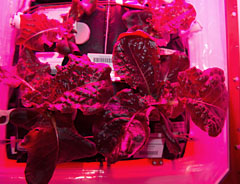
NASA Public Domain Image
August 10, 2015
First Food Grown in Space and Eaten
The crew of the International Space Station (ISS) become the first astronauts to eat food grown in space. The crew of ISS Expedition 44 enjoy some red romaine lettuce that was grown for 15 months on board the space station using a system called Veg-01, which uses red, blue, and green LED lights to grow plants in a small space. This artificial garden is is part of NASA's research into food provision for a manned mission to Mars.

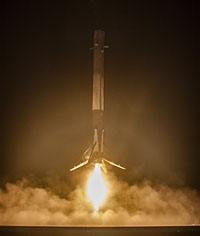
SpaceX Photos / CC0
December 21, 2015
First Propulsive Landing of an Orbital Rocket
Private space company SpaceX makes the first successful vertical landing of an orbital booster rocket. The rocket booster was successfully returned to its landing zone near the launch site after placing 11 Orbcomm-OG2 satellites into orbit. This successful landing was the result of a five-year technology development program by SpaceX to develop a reusable rocket system that would significantly reduce the cost of launching payloads into orbit.
2018

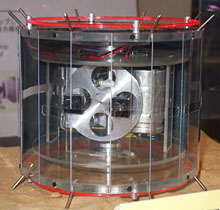
User: Norimaki / CC BY 3.0
September 21, 2018
First Operational Rover on an Asteroid
Japan Aerospace Exploration Agency (JAXA) becomes the first to land moving rovers on the surface of an asteroid. The Hayabusa2 spacecraft successfully deploys two rovers called MINERVA-II 1A and 1B to the surface of an asteroid known as Ryugu. The rovers use rotating motors to make jumps, each lasting about 15 minutes due to the asteroid's’s low gravity. The probes send back a series of color photographs before losing contact with Earth as they pass around to the far side of the asteroid.
2019

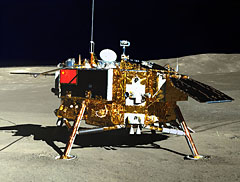
Image © China National
Space Administration (CNSA)
January 3, 2018
First Soft Landing on the Far Side of the Moon
China's robotic Chang'e 4 spacecraft touches down on the floor of the 115-mile-wide (186 kilometers) Von Kármán Crater, making the first-ever soft landing on the far side of the Moon. The spacecraft deploys a lunar rover to explore this mysterious part of the Moon that has never been seen from the surface. To communicate with the rover, China launches a relay satellite called Queqiao a few months later in May. This satellite is positioned at the Earth-moon Lagrange point 2, a gravitationally stable spot beyond the moon where the satellite can communicate with both Chang'e 4 and the Earth.

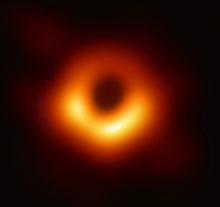
Event Horizon Telescope / CC BY 4.0
April 10, 2019
First Image of a Black Hole
Astronomers release the first ever image of a black hole. The image was captured by the Event Horizon Telescope (EHT), a network of eight linked telescopes around the world. It shows a black hole in a galaxy known as M87. The black hole is believed to have a mass more than 6.5 billion times that of the Sun and is among the most massive black holes ever discovered. The image clearly shows a ring of super heated gas falling into the hole's event horizon, which is visible as the black region in the center.

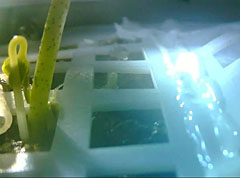
Image © Chongqing University
January 3, 2018
First Seeds Germinated on Another Celestial Body
After successfully landing on the far side of the Moon, China's Chang'e 4 lunar lander reveals a secret payload consisting of a sealed biosphere cylinder containing plant seeds. After watering the seeds and adjusting the temperature in the cylinder, the cottonseeds, rapeseeds and potato seeds sprouted and began to grow. The experiment was supposed to run for 100 days but was terminated after only nine days due to an unexpected temperature drop in the biosphere. In spite of this failure, valuable information was obtained.
2020

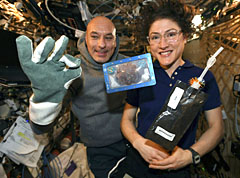
NASA Public Domain Image
January 7, 2020
First Food Baked in Space
Chocolate chip cookies become the first food to be baked in space in a first-of-its-kind experiment. The 5 cookies are baked one at a time in a special zero gravity oven by the crew of the International Space Station (ISS). The cookies take a little over two hours to cook thoroughly in the microgravity environment aboard the space station. This is much longer than anyone expected. The cookies are returned to Earth on January 7 for research. One of these space cookies will be on display at the Smithsonian's National Air and Space Museum.

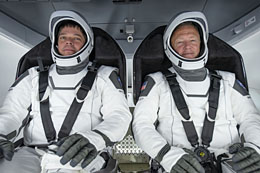
NASA / SpaceX / CC0
May 30, 2020
First Commercial Manned Space Mission
SpaceX makes history as the first private company to launch astronauts into space. The Crew Demo 2 test flight successfully launches two astronauts into orbit on a mission to the International Space Station (ISS). Spacecraft commander Douglas Hurley and joint-operations commander Robert Behnken become the first astronauts to be launched into space by a private company. This mission marks the return of America's manned space program since the space shuttle program ended in 2011.




